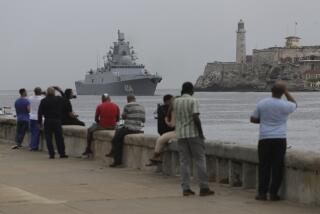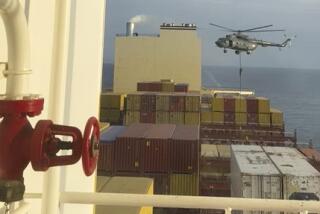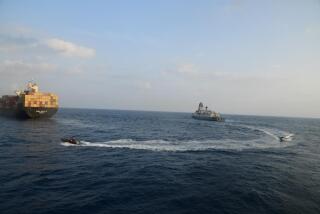Cuban Emigres Reportedly Kill Navy Officer, Hijack Boat : Caribbean: The U.S. Coast Guard says it intercepted a vessel matching the description of the seized ship.
MIAMI — In a sign that political unrest in Cuba is continuing, Cuban hijackers commandeered a naval vessel, killed a Cuban naval officer and set sail for the United States, U.S. and Cuban officials said Tuesday.
The Coast Guard said it had intercepted a 50-foot green-hulled vessel that matched the description of the hijacked ship but was not certain it was the same vessel. About 27 would-be emigres were taken into custody.
The hijacking, reported to U.S. authorities late Monday by Cuban border police, was the fourth such incident since July 26 and came just three days after an unprecedented riot in Havana that was quelled by police firing into the air.
The Clinton Administration reacted cautiously to the hijacking. Although the Pentagon insisted that Washington had not yet taken action to prepare for a mass exodus of Cubans, the State Department condemned what it called a “disturbing trend” toward violence.
“We recognize that people fleeing (President Fidel) Castro’s tyranny need our help and compassion, but the reported use of sometimes lethal violence by those taking over vessels to flee the island is a disturbing trend,” spokesman David Johnson told reporters.
But at the same time, Johnson said the Administration is not considering any change in its policy toward Cuba as a result of the incidents. “We will not allow Castro to dictate our policy on immigration or any other issue,” he said.
Castro has said the United States invites Cubans to flee the island by taking them in and that he wants America to “guard its coast” against Cuban immigration.
U.S. officials renewed their appeals to Cuban Americans in Miami--many of whom own small boats and are reportedly ready to pick up refugees who make it into international waters--not to intervene.
Coast Guard officials said the Cuban vessel apparently was hijacked at Mariel, the port from which Castro launched a flood of emigres in 1980. The ship was intercepted 35 miles north of Cuba en route to Key West, Fla.
U.S. authorities had no immediate explanation for why Navy and Coast Guard ships and search aircraft had not been able to locate the hijacked vessel until late Tuesday.
The hijacking took place late Monday afternoon as the Cuban vessel was docked. “People that came from land boarded it and attacked and killed this lieutenant,” said Rafael Dausa, a political officer in the Cuban Interests Section in Washington. “A group of persons took the boat, attacked the boat, assaulted the boat and hijacked the vessel.”
He blamed the hijacking on “delinquents and vandals” and asked the U.S. government to return them to Cuba. In dozens of cases over the years, in which Cubans have hijacked boats and planes--including MIG fighter jets--and come to the United States, no defector has ever been returned.
But never before has a military vessel been hijacked. And, coming after the unrest in Cuba, the incident was enough to spark another round of jubilation among Cuban Americans who want nothing more than the end of Castro’s 35-year Communist regime.
“Even if the immediate crisis passes, there is so much discontent that riots are going to happen again at any moment,” said Arturo Cobo, director of the Transit Home for Cuban Rafters in Key West, which helps resettle refugees.
The last week in Cuba has been tumultuous, posing what many believe to be the most serious threat yet to Castro. Without Russian sponsorship, the Cuban economy has steadily deteriorated and the scarcity of food is growing worse.
The current unrest appeared to begin with the July 13 sinking of a tugboat on which dozens were trying to flee to the United States. More than 30 people died when Cuban patrol boats rammed the vessel, survivors said. Thirteen days later the first of three ferry boat hijackings took place in Havana, incidents that brought 130 Cubans to Key West.
Friday afternoon, thousands gathered on the docks in Havana, apparently in response to rumors that boats were available to take them to Miami. As police moved in to break up the crowd--estimated anywhere from 5,000 to 15,000--plainclothes police fired shots into the air. As people began to scatter, rocks were thrown, anti-Castro chants were heard and clashes between police and crowds grew intense, according to wire service reports and an amateur videotape shown widely in Miami.
According to a report issued by the Coordinating Board for Human Rights Organizations in Cuba, more than 500 people were arrested and nearly 100 were injured.
Later Friday, Castro visited the area and accused the United States of fomenting trouble by encouraging Cubans to flee to Florida. He then threatened to touch off another Mariel boat lift by inviting Cubans in the United States to come and pick up relatives on the island.
Ramon Cernuda, a Miami resident who represents a coalition of human rights groups on the island, said Friday’s events were “the first time a demonstration has openly taken place against the government and also the first time that large groups of young Cubans have dared to defy the police, acting out in civil disobedience.”
There is a classified plan in place that details the federal and state response if another Mariel-type exodus were to begin, government sources said. Called “Operation Distant Shore,” the plan calls for a naval blockade of the Florida Straits to stop boats arriving from Cuba and the seizure of U.S. vessels used to bring in immigrants. Those who do get through would be detained outside Florida; those who ferry them in would be prosecuted, sources familiar with the document said.
Meanwhile, Cubans continue to leave Cuba the way they have for years: by raft. Over the weekend, more than 440 refugees showed up for processing in Key West, Cobo said. The Coast Guard reports assisting 5,163 Cubans into the United States this year, more than any year since 1980.
More to Read
Sign up for Essential California
The most important California stories and recommendations in your inbox every morning.
You may occasionally receive promotional content from the Los Angeles Times.










